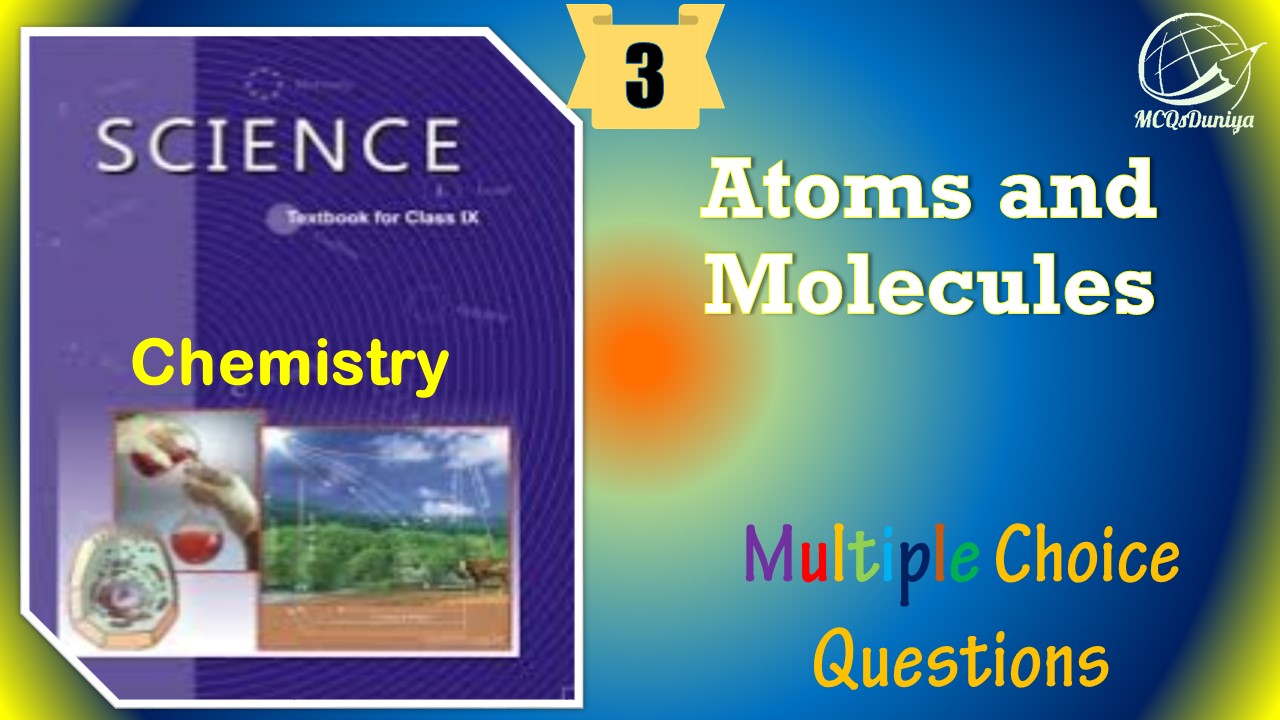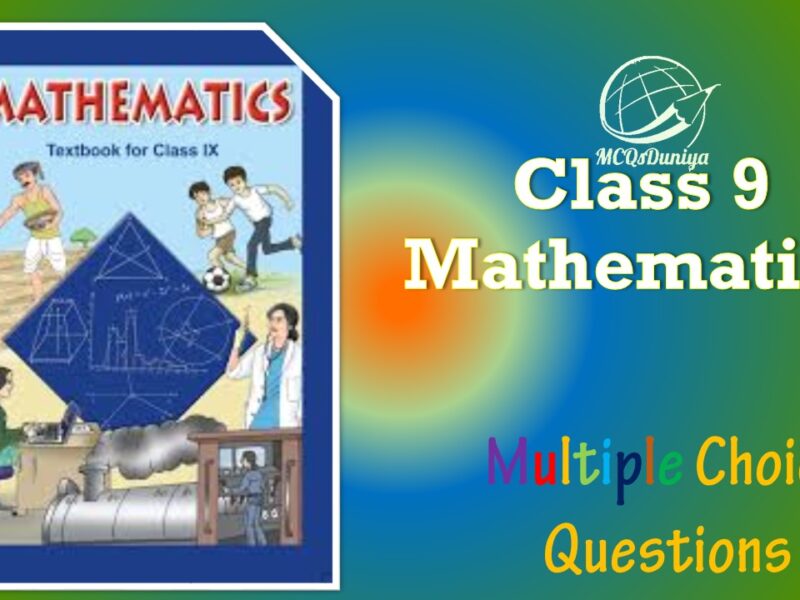Class 9 Science MCQ Atoms and Molecules with Answers is Prepared Based on Latest Exam Pattern. Students can solve NCERT Class 9 Science MCQ Atoms and Molecules with Answers to know their preparation level.
Students who are searching for NCERT Class 9 Science MCQ Atoms and Molecules with Answers are compiled here to get good practice on all fundamentals. Know your preparation level on MCQ Questions for Class 9 Science MCQ Atoms and Molecules with Answers. You can also verify your answers from the provided Class 9 Science MCQ Atoms and Molecules with Answers. So, ace up your preparation with MCQ of Class 9 Science MCQ & NCERT Textbook solutions Examinations.
NCERT Class 9 Science MCQ Atoms and Molecules with Answers
Question :Who coined the term ‘Parmanu’ for the smallest indivisible particles?
(a) Leucippus
(b) L. Lavoisier
(c) Kanad
(d) None of them
Answer : (c) KanadShow Answer :
Question :The radius of a hydrogen atom is:
(a) 10-2
(b) 10-4
(c) 10-9
(d) 10-10
Answer : (d) 10-10Show Answer :
Question :The most remarkable concept that Dalton’s atomic theory proposed was that of the:
(a) atomic weight
(b) atomic mass
(c) molar mass
(d) none of them
Answer : (b) atomic massShow Answer :
Question :The atomic mass of carbon is:
(a) 12
(b) 14
(c) 16
(d) 23
Answer : (a) 12Show Answer :
Question :Compounds composed of metals and non-metals contain:
(a) non-charged species
(b) charged species
(c) both of them
(d) none of them
Answer : (b) charged speciesShow Answer :
Question :The formula of ammonium sulphate is:
(a) NHSO4
(b) NH4SO2
(c) NHSO3
(d) (NH4)2SO4
Answer : (d) (NH4)2SO4Show Answer :
Question :The word “mole” was introduced around 1896 by:
(a) Wilhelm Ostwald
(b) John Dalton
(c) Avogadro
(d) Vergilious
Answer : (a) Wilhem OstwaldShow Answer :
Question :The chemical symbol for sodium is:
(a) So
(b) Sd
(c) NA
(d) Na
Answer : (d) NaShow Answer :
Question :Which of the following has a maximum number of atoms?
(a) 18 g of H2O
(b) 18 g of O2
(c) 18 g of CO2
(d) 18 g of CH4
Answer : (d) 18 g of CH4Show Answer :
Question :Which of the following contains a maximum number of molecules?
(a) 1g CO2
(b) 1g N2
(c) 1g H2
(d) 1g CH4
Answer : (c) 1g H2Show Answer :
Question : The radius of a hydrogen atom is:
(a) 10-2
(b) 10-4
(c) 10-9
(d) 10-10
Answer :(d)Show Answer :
Question : Which of the following is correct pair of elements and its symbol?
(a) Silver – Si
(b) Sodium – So
(c) Potassium – Pt
(d) Sulphur – S
Answer :(d) Sulphur – SShow Answer :
Question : The chemical symbol for sodium is
(a) So
(b) Sd
(c) NA
(d) Na
Answer :(d) NaShow Answer :
Question : 1 u or 1 amu means
(a) 1/12th mass of C-12 atoms
(b) Mass of C-12 atom
(c) Mass of O-16 atom
(d) Mass of Hydrogen molecule
Answer :(a) 1/12th mass of C-12 atomsShow Answer :
Question : The atomic mass of carbon is:
(a) 12
(b) 14
(c) 16
(d) 23
Answer :(a) 12Show Answer :
Question : How many moles are present in 40 g of He?
(a) 10 moles
(b) 11 moles
(c) 13 moles
(d) 12 moles
Answer :(a) 10 molesShow Answer :
Question : Which of the following has maximum number of atoms?
(a) 18 g of H2O
(b) 18 g of O2
(c) 18 g of CO2
(d) 18 g of CO4
Answer :(d)Show Answer :
Question : A sample of NH3 molecule irrespective of source contains 82.35% Nitrogen and 17.65% of Hydrogen by mass. This data supports:
(a) Law of Conservation of Mass
(b) Las of Multiple Proportions
(c) Law of Definite Proportions
(d) Avogadro’s Law
Answer :(c) Law of Definite ProportionsShow Answer :
Question : The word “mole” was introduced around 1896 by:
(a) Wilhelm Ostwald
(b) John Dalton
(c) Avogadro
(d) Vergilious
Answer :(a) Wilhem OstwaldShow Answer :
Question : Which of the following is the major drawback of Dalton’s atomic theory?
(a) Atoms of an element have exactly the same mass.
(b) Atoms are indivisible.
(c) Atoms of different elements have different masses.
(d) All of the above
Answer :(b) Atoms are indivisible.Show Answer :
Question : A change in the physical state can be brought about
(a) only when energy is given to the system
(b) only when energy is taken out from the system
(c) when energy is either given to, or taken out from the system
(d) without any energy change
Answer :(c) when energy is either given to, or taken out from the systemShow Answer :
Question : 3.42 g of sucrose are dissolved in 18 g of water in a beaker. The numbers of oxygen atoms in the solution are:
(a) 6.68 ×1023
(b) 6.09 ×1022
(c) 6.022 ×1023
(d) 6.022 ×1021
Answer :(i)Show Answer :
Question : Which of the following has a maximum number of atoms?
(a) 18 g of H2O
(b) 18 g of O2
(c) 18 g of CO2
(d) 18 g of CH4
Answer :(d)Show Answer :
Question : 9 grams of water decompose to give:
(a) 4g oxygen and 16g hydrogen
(b) 2g hydrogen and 1g oxygen
(c) 8g oxygen and 1g hydrogen
(d) none
Answer :(c) 8g oxygen and 1g hydrogenShow Answer :
Question : The relative molecular mass of Na2S2O3.5H2O is
(a) 250 amu
(b) 250 g
(c) 248 amu
(d) 248 g
Answer :(c) 248 amuShow Answer :
Question : The atomic mass of sodium is 23. The number of moles in 46g of sodium is
(a) 4
(b) 2
(c) 0
(d) ½
Answer :(b) 2Show Answer :
Question : Who coined the term ‘Parmanu’ for the smallest indivisible particles?
(a) Leucippus
(b) L. Lavoisier
(c) Kanad
(d) None of them
Answer :(c) KanadShow Answer :
Question : What is the mass of 0.5 mole of Hydrogen atom
(a) 2.0 g
(b) 1.5 g
(c) 1 g
(d) 0.5 g
Answer :(d) 0.5 gShow Answer :
Question : Percentage of calcium in calcium carbonate is
(a) 40
(b) 30
(c) 48
(d) 36
Answer :(a) 40Show Answer :
Question : What is the formula mass unit of ZnO?
(a) 18 u
(b) 81 u
(c) 88 u
(d) 188 u
Answer :(b) 81 uShow Answer :
Question : Calculate the formula unit mass of ZnCl2?
(a) 137 u
(b) 124 u
(c) 123 u
(d) 111 u
Answer :(a) 137 uShow Answer :
Question : How many times an atom of sulphur is heavier than an atom of carbon?
(a) 32 times
(b) 12 times
(c) 8/3 times
(d) 12/32 times
Answer :(c) 8/3 timesShow Answer :
Question : What is the number of moles present in 62 g of P4molecules?
(a) 0.25 moles
(b) 0.5 moles
(c) 1 mole
(d) 2 moles
Answer :BShow Answer :
Question : What mass of calcium contains the same number of atoms as present in 2.3 g of sodium?
(a) 40 g
(b) 13.8 g
(c) 9.2 g
(d) 4 g
Answer 😀Show Answer :
Question : Barium chloride reacts with sulphuric acid according to the following reaction:
BaCl2+ H2SO4→ BaSO4+ 2HCl
The masses of BaCl2and H2SO4solutions used were 6.3 g and 8.7 g respectively. If the mass of HCl formed was 5.8g, what would be the mass of BaSO4formed?
(a) 9.2 g
(b) 10.2 g
(c) 10.8 g
(d) 11.2 g
Answer :AShow Answer :
Question : Calcium carbonate on heating forms calcium oxide and carbon dioxide. If 25 g of CaCO3on heating formed 14 g of CaO, calculate the amount of CO2that escaped into the air.
(a) 22 g
(b) 14 g
(c) 11 g
(d) 5.5 g
Answer :CShow Answer :
Question : What is the mass of 3.011 × 1023atoms of hydrogen?
(a) 2 g
(b) 1 g
(c) 0.5 g
(d) 0.25 g
Answer :CShow Answer :
Question : Calculate the mass of 0.25 moles of Cl2gas.
(a) 284 g
(b) 71 g
(c) 35.5 g
(d) 17.75 g
Answer 😀Show Answer :
Question : What is the Latin name for sodium?
(a) Ferrum
(b) Kalium
(c) Cuprum
(d) Natrium
Answer 😀Show Answer :
Question : One atomic mass unit is equal to
(a) 1/16th of the mass of an O-16 atom.
(b) 1/17th of the mass of an O-17 atom.
(c) 1/12th of the mass of a C-12 atom.
(d) 1/13th of the mass of a C-13 atom.
Answer :CShow Answer :
Question : The ion is a monoatomic ion.
(a) sulphate
(b) ammonium
(c) calcium
(d) carbonate
Answer :CShow Answer :
Question : Which of the following is a polyatomic ion?
(a) Sulphide
(b) Chloride
(c) Nitride
(d) Nitrate
Answer 😀Show Answer :
Question : 1.08 g of a sample of a compound of nitrogen and oxygen on analysis gave 0.28 g of nitrogen and 0.80 g of oxygen. What is the percentage of nitrogen present in this compound?
(a) 74.07 %
(b) 35 %
(c) 25.93 %
(d) 15 %
Answer :CShow Answer :
Question : What is the value of Avogadro’s constant?
(a) 1.66 × 10–24
(b) 9.1 × 10–31
(c) 6.022 × 1020
(d) 6.022 × 1023
Answer 😀Show Answer :
Question : The ratio by mass of hydrogen and chlorine in hydrogen chloride is
(a) 3 : 35.5.
(b) 35.5 : 3.
(c) 1 : 35.5.
(d) 35.5 : 1.
Answer :CShow Answer :
Question : Hydrazine is a compound of nitrogen and hydrogen. The ratio by mass of nitrogen and hydrogen in this compound is 7 : 1. If the mass of hydrogen in hydrazine is 4 g, what is the mass of nitrogen?
(a) 7 g
(b) 11 g
(c) 28 g
(d) 56 g
Answer :CShow Answer :
Question : According to the , during a chemical reaction, mass can neither be created nor be destroyed.
(a) law of conservation of mass
(b) law of constant proportions
(c) law of multiple proportions
(d) law of combining volumes
Answer :AShow Answer :
Question : The ratio of hydrogen and oxygen in a sample of water collected from a well was found to be 1 : 8 by mass. When a sample of water was collected from a pond and analysed, the ratio of hydrogen and oxygen in it was also found to be 1 : 8 by mass. This data is in accordance with the
(a) law of conservation of mass.
(b) law of constant proportions.
(c) law of multiple proportions.
(d) law of combining volumes.
Answer :BShow Answer :
Question : What is the chemical formula of magnesium phosphate?
(a) Mg2(PO4)3
(b) Mg3(PO4)2
(c) Mg3(PO4)
(d) Mg(PO4)2
Answer :BShow Answer :
Question : The chemical compound of sodium hydrogen carbonate is
(a) NaHCO3.
(b) Na2HCO3.
(c) NaCO3.
(d) Na2CO3.
Answer :AShow Answer :
Question : Name the smallest particle of an element or a compound which can exist independently and shows the properties of that substance.
(a) Atom
(b) Molecule
(c) Anion
(d) Cation
Answer :BShow Answer :
Question : What is the atomicity of a phosphorus molecule?
(a) Two
(b) Three
(c) Four
(d) Eight
Answer :CShow Answer :
Question : Which of the following compounds has the chemical formula ZnSO3?
(a) Zinc sulphite
(b) Zinc sulphide
(c) Zinc sulphate
(d) Zinc hydrogen sulphate
Answer :AShow Answer :
Question : Calculate the mass percentage of carbon in methane (CH4).
(a) 75 %
(b) 33.3 %
(c) 25 %
(d) 20 %
Answer :AShow Answer :
Question : What is the number of atoms of oxygen present in 0.5 moles of O2?
(a) 6.022 × 1023
(b) 3.011 × 1023
(c) 6.022 × 1020
(d) 3.011 × 1020
Answer :AShow Answer :
Question : mole(s) of Br2contain 6.022 × 1023atoms of bromine.
(a) 2
(b) 1
(c) 0.5
(d) 0.25
Answer :CShow Answer :
Question : Which of the following is a monoatomic element?
(a) Fluorine
(b) Sulphur
(c) Argon
(d) Ozone
Answer :CShow Answer :
Question : is an ionic compound.
(a) CCl4
(b) H2S
(c) N2O5
(d) K2SO4
Answer 😀Show Answer :
Question : The chemical formula of ethanol is C2H5OH. Calculate its molecular mass.
(a) 34 u
(b) 38 u
(c) 46 u
(d) 52 u
Answer :CShow Answer :
Question : Calculate the formula unit mass of MgCl2.
(a) 46 g
(b) 59.5 g
(c) 83 gd
(d) 95 g
Answer 😀Show Answer :
Fill in the Blanks.
Question :In a compound such as water, the ratio of the mass of hydrogen to the mass of oxygen is always ______
Answer : 1 : 8Show Answer :
Question :Atomic radius is measured in ________
Answer : nanometreShow Answer :
Question :The symbol of iron is Fe from its Latin name _________
Answer : FerrumShow Answer :
Question :One atomic mass unit is a mass unit equal to exactly ________ the mass of one atom of carbon-12.
Answer : Show Answer :
Question :The formula unit mass of a substance is a sum of the atomic ______ of all its constituent atoms.
Answer : massesShow Answer :
Question :Avogadro number is represented by ________
Answer : N0Show Answer :
Question :The relative mass of atoms of all elements is obtained by comparing them with the mass of a _______ atom.
Answer : Carbon-12Show Answer :
Question :The Avogadro constant 6.022 × 1023 is defined as the number of atoms in exactly ______ of carbon-12.
Answer : 12 gShow Answer :
True/False.
Question :An atom is the smallest particle of the element that cannot usually exist independently and retains all its chemical properties.
Answer : TrueShow Answer :
Question :The Law of conservation of mass states that mass can neither be created nor destroyed in a chemical reaction.
Answer : TrueShow Answer :
Question :The mass of 1 mole of a substance is equal to its relative atomic or molecular mass in grams.
Answer : TrueShow Answer :
Question :16u oxygen has 16 atoms of oxygen.
Answer : FalseShow Answer :
Question :The atomic mass of calcium is 40.
Answer : TrueShow Answer :
Question :Aluminium is diatomic.
Answer : FalseShow Answer :




